B2.8 Multiply and divide one-digit whole numbers by unit fractions, using appropriate tools and drawings.
Skill: Multiplying One-Digit Whole Numbers by Unit Fractions
In the junior grades, students already have a wealth of knowledge about multiplication. In fact, they have explored concepts related to multiplication using concrete materials, visuals, calculators, and symbols since the primary grades. In Grade 4, multiplying fractions was limited to multiplying a one-digit whole number by a unit fraction. This type of multiplication can be understood by relating it to repeated addition. Thus, students easily grasp that \(3\; \times \;\frac{1}{2}\), which can be read as "3 times one half" is a multiplication which can be represented by repeated addition (that is \(\frac{1}{2}\; + \;\frac{1}{2}\; + \;\frac{1}{2}\)). It is more difficult to make sense of multiplying a fraction by a whole number (for example, \(\frac{1}{2}\; \times \;3\)), which is explored in Grade 5 onwards. There is a connection between the concept of multiplying by a fraction and that of a fraction of a set. For example, in Grade 2, students learn the meaning of \(\frac{1}{2}\), \(\frac{1}{4}\), and \(\frac{1}{3} \) of a group of up to 10 objects. Later, they consolidated their understanding of fractions of a set. In Grade 5, by examining the concept of multiplying a unit fraction by a one-digit whole number, they will learn that the fraction of a set (\(\frac{1}{3}\)of 6 ) is related to multiplication and that this situation can be represented by a multiplication (\(\frac{1}{3}\; \times \;6\)).
We can make connections to the concept of multiplication of whole numbers by reasoning this way:
- we can consider \(4\; \times \;6\) as 4 groups of 6;
- we can consider \(2\; \times \;8\) as 2 groups of 8.
There is no difficulty in extending this observation to mixed numbers greater than 2:
- we can consider \(4 \frac{1}{2}\; \times \;6\) as 4 and one half groups of 6;
- we can consider \(2\frac{1}{3}\; \times \;12\) as 2 and one third groups of 12.
We generalize this situation (which implies an abstraction, since the group is not "multiplied" as such) by adding that:
- we want to consider \(1\frac{1}{2}\; \times \;6\) as 1 and one half groups of 6;
- we want to consider \(\frac{1}{2}\; \times \;6\) as one half group of 6.
Thus, we can interpret this operation as \(\frac{1}{2}\) of 6 and as \(\frac{1}{2}\) x 6.
Example
In a Grade 6 classroom, \(\frac{1}{2}\) of the students are wearing toques.
If there are 24 students in the classroom, how many students are wearing toques?
- Multiplication performed using the set model
To determine \(\frac{1}{2}\) of 24, I lay out 24 counters and take half of them.
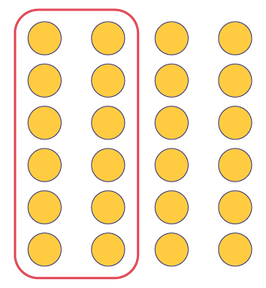
Half (\(\frac{1}{2}\)) of 24 counters is 12. There are therefore 12 students wearing a toque.
- Multiplication performed using a number line
To determine \(\frac{1}{2}\) of 24, I divide 24 by 2, which gives me 12.
I represent the 24 students below the line and half of 24 above the line.
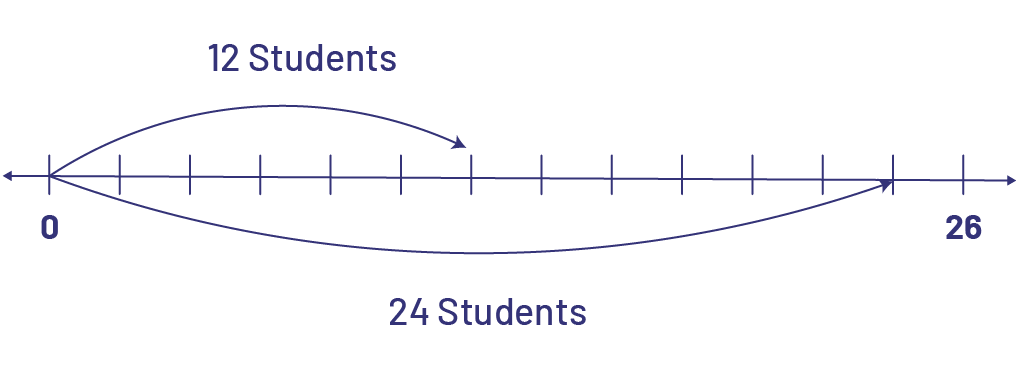
There are 12 students wearing toques.
In this grade, by focusing on concepts and context, it is more relevant to deepen the meaning of the fraction of a whole when performing a calculation (for example, \(\frac{1 }{3}\) of 24) than to focus on the multiplication of a fraction by a whole number (\(\frac{1}{3}\; \times \;24\)).
Source: adapted and translated from Guide d'enseignement efficace des mathématiques de la 4e à la 6e année, Numération et sens du nombre, Fascicule 2, Fractions, p. 78-79.
Skill: Dividing a One-Digit Whole Number by a Unit Fraction, Using Tools and Drawings
In order to understand a division, it is essential to examine the meaning of division and the nature of the numbers used in it. Division has the meaning of sharing (partitive) when we look for the size of the groups; it has the meaning of grouping (quotative or measurement) when we look for the number of groups.
Source: translated from Guide d'enseignement efficace des mathématiques de la 4e à la 6e année, Numération et sens du nombre, Fascicule 2, Fractions, p. 80.
Thus, dividing a whole number by a fraction (for example, \(2\; \div \;\frac{1}{3}\)) can be represented using grouping. In this case, the fraction is the divisor.

For example, if we have 2 licorice chews and we want to give \(\frac{1}{3}\) of the licorice to each child, we need to separate or measure out one quantity (2 licorice chews) into equal quantities of \(\frac{1}{3}\) of the licorice. This will allow us to determine the number of equal quantities (or groups) that can be created. In this case, we can make 6 groups of \(\frac{1}{3}\), so 6 children will receive the licorice. It is important to recognize that the quotient represents the number of groups, not a quantity of objects (licorice chews).
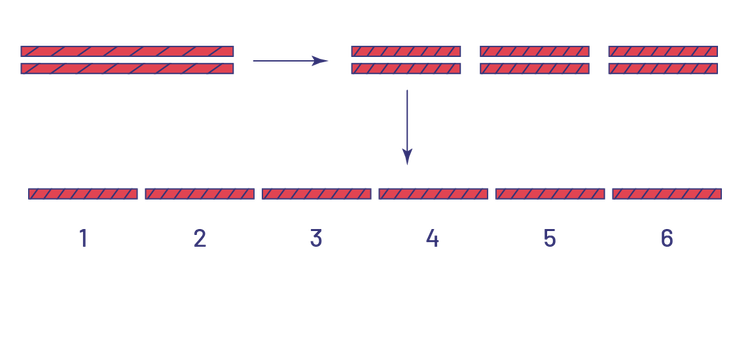
Source: translated from Guide d'enseignement efficace des mathématiques de la 4e à la 6e année, Numération et sens du nombre, Fascicule 2, Fractions, p. 81-82.
The analogy of repeated subtraction is appropriate since it involves separating out parts.
Example
When dividing \(2\; \div \;\frac{1}{4}\), we can think of \(2\; - \; \frac{1}{4}\; - \;\frac{1}{4}\; - \;\frac{1}{4}\; - \;\frac{1}{4}\; - \;\frac{1}{4}\; - \;\frac{1}{4}\; - \;\frac{1}{4}\; - \;\frac{1}{4}\) and we can create 8 groups of \(\frac{1}{4}\). However, the group created may be rather abstract since it is a group that is a fraction of a whole. The questions "How many \(\frac{1}{4}\) can be created with 2 wholes?" and "How many times does \(\frac{1}{4}\) go in 2?" can help visualize the operation.
Example
\(4\; \div \;\frac{1}{3}\; = \;12\)
Area Model
How many pieces of pie can be offered if there are 4 pies and each piece is \(\frac{1}{3}\) of one pie?
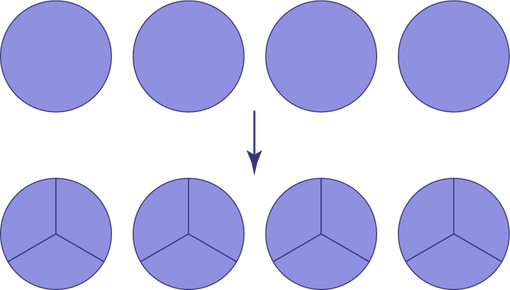
Linear Model
Mathieu is making cakes. He needs 3 eggs to make 1 cake. If he has one dozen of eggs, how many cakes can he make?
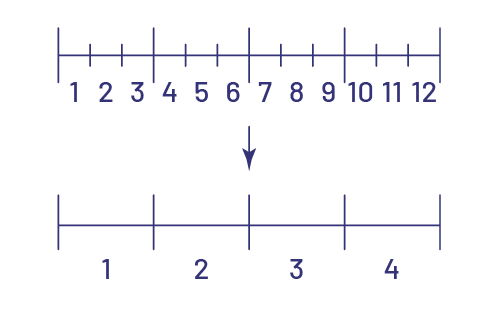
Source: translated from Guide d'enseignement efficace des mathématiques de la 4e à la 6e année, Numération et sens du nombre, Fascicule 2, Fractions, p. 100-101.
Knowledge: Unit Fractions
Any fraction that has a numerator of 1.
Examples
\(\frac{1}{3}\), \(\frac{1}{9}\)
Source: Ontario Curriculum, Mathematics, Grades 1-8, 2020, Ontario Ministry of Educaiton.
